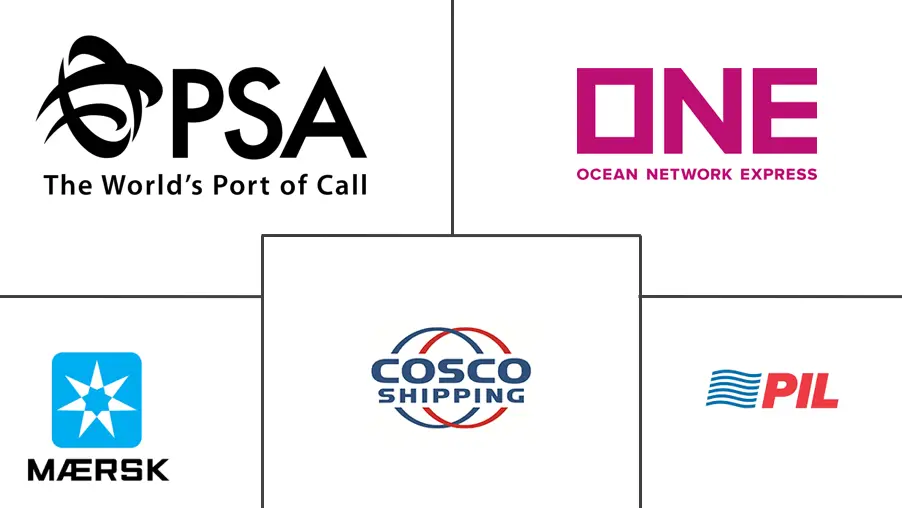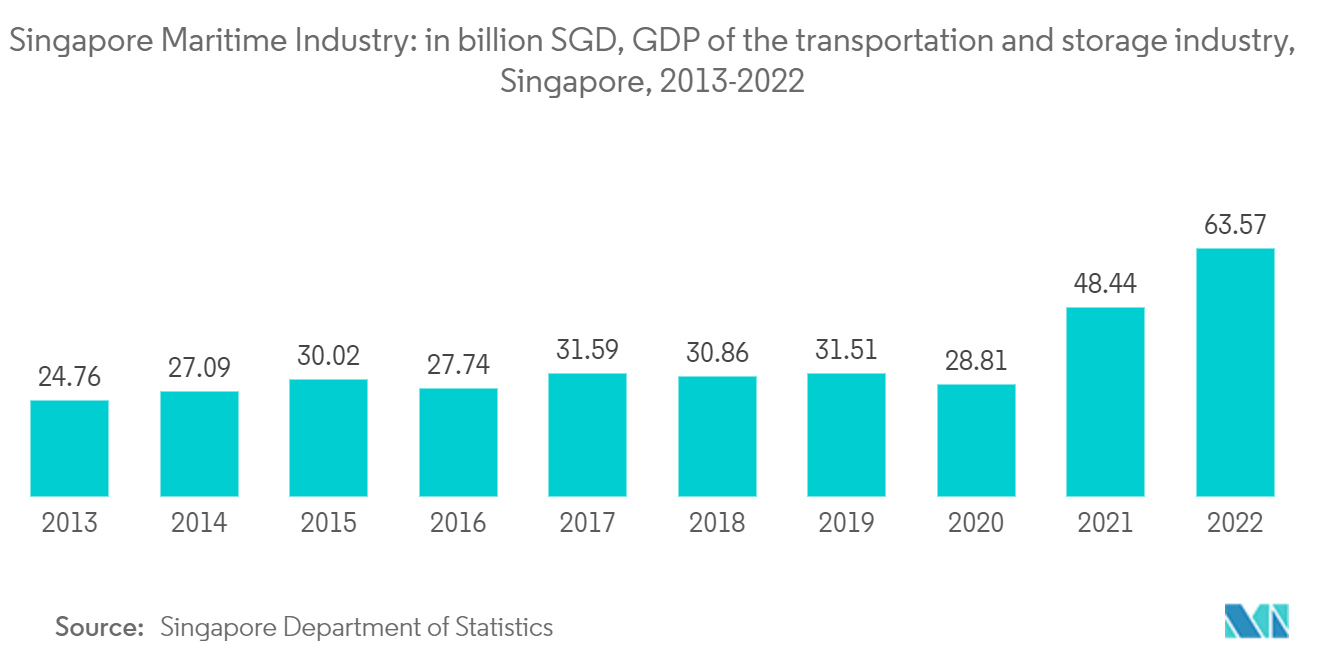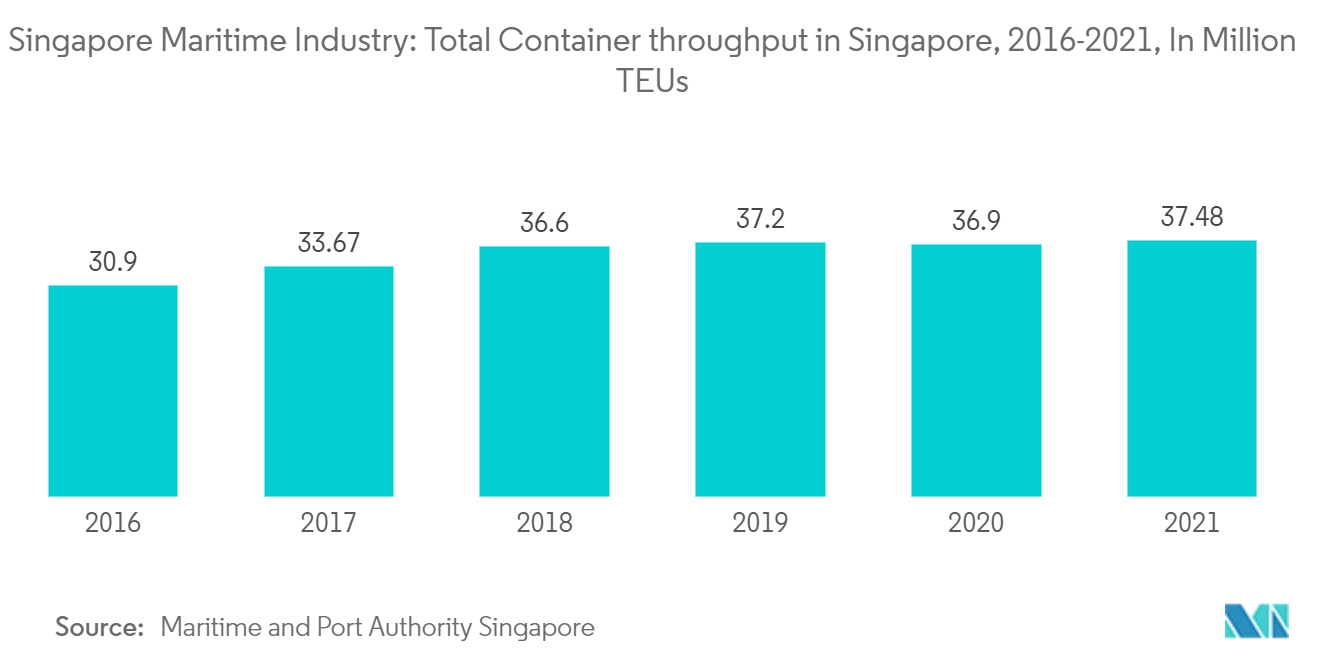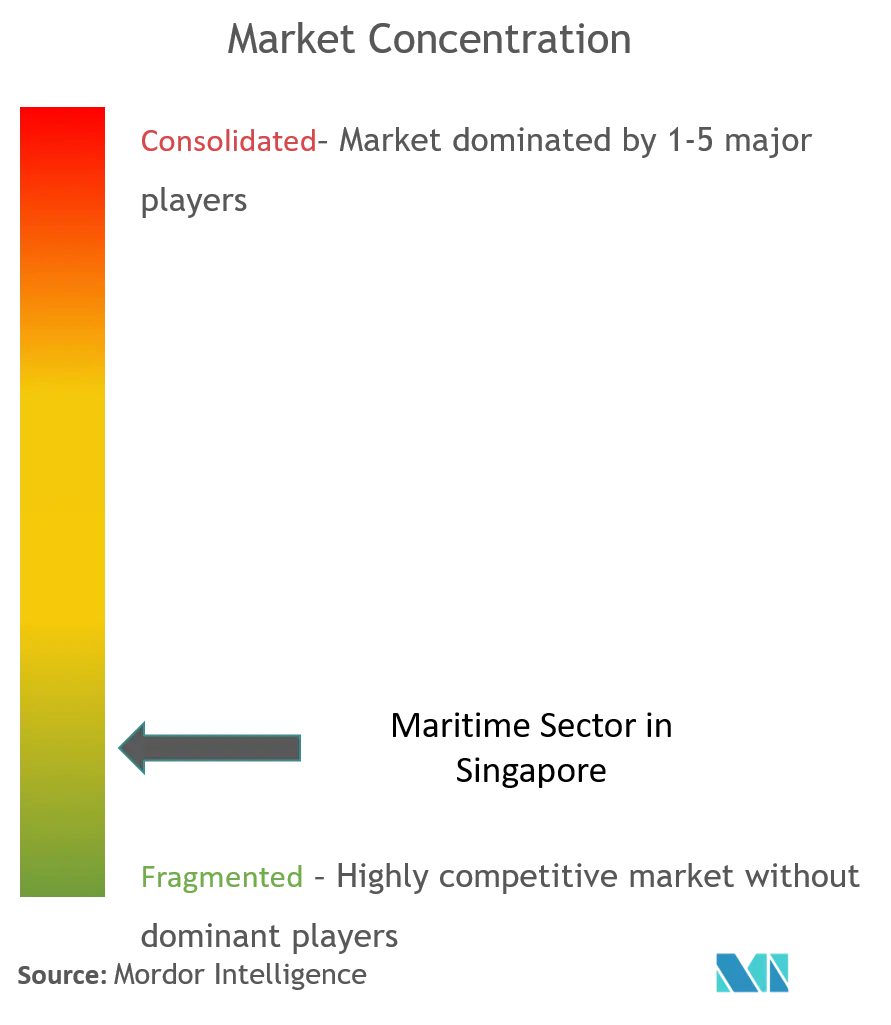Singapore Maritime Market Size

| Study Period | 2020 - 2029 |
| Base Year For Estimation | 2023 |
| Market Size (2024) | USD 4.75 Billion |
| Market Size (2029) | USD 6.00 Billion |
| CAGR (2024 - 2029) | 4.79 % |
| Market Concentration | Medium |
Major Players
*Disclaimer: Major Players sorted in no particular order |
Singapore Maritime Market Analysis
The Maritime Industry in Singapore Market size is estimated at USD 4.75 billion in 2024, and is expected to reach USD 6 billion by 2029, growing at a CAGR of 4.79% during the forecast period (2024-2029).
Singapore has crossed the 100,000 mark for crew change carried out at the port during the ongoing coronavirus (COVID-19) pandemic, according to the Maritime and Port Authority of Singapore (MPA). Since 27 March 2020, MPA has facilitated 100,000 sign-on and sign-off crew of all nationalities from ships of different flags involving more than 5,000 companies and 6,700 ships.
Singapore is a premier global hub port and an international maritime center. Every year, 130,000 vessels enter into ports. At any given time, there are about 1,000 vessels in Singapore’s waters. More than 1,000 tonnes of cargo are handled in the ports every minute. Singapore has retained its position as the world’s second-busiest container port and the number-one bunkering port in 2020. It has also facilitated crew change for more than 80,000 seafarers amid the coronavirus (COVID-19) pandemic.
Connected to more than 600 ports in over 120 countries, Singapore’s global network allows goods to be transported efficiently anywhere. However, competition is also heating up as regional ports build more capacity and invest in new technology. Emerging technologies are transforming the nature of shipping, with automation, digitalization, and real-time data sharing improving the efficiency of port management and sea transport industries globally.
Maritime is steeped in the lifeblood of Singapore, with its illustrious relationship tracing back to its beginning as a hub for entrepot trade in the nation’s early days. After playing such a critical role in Singapore’s development from a third-world to a first-world nation within one generation, the maritime sector now continues to be a significant engine of growth for Singapore’s economy, making up 7% of the nation’s GDP and employing more than 170,000 people in various technical and commerce-related functions.
Singapore Maritime Market Trends
Development of Ports in the Country
The Government of Singapore continues to invest in transport infrastructure to maintain the country’s position as a world-class city and key transport mode between Asia and the world.
Tuas Port is being developed as the next-generation container port in Singapore. When fully completed in the 2040s, after construction of up to 30 years, Tuas Port will be the world’s single largest container port, capable of handling up to 65 million TEU per annum. The new port is to accommodate the move of the current city terminals when their leases expire and will be the consolidated location for all of Singapore’s container activities, significantly reducing inter-terminal haulage operations and greenhouse gas emissions.
To adapt to rising sea levels, Tuas Port will have an operational platform of five meters above maximum sea level, with over 50% of the total fill materials coming from dredged material and excavated earth from construction. Reusing such materials reduces reliance on the sand for reclamation, saving over SGD 2 billion in material costs. Reclamation began in 2015 and was completed in 2021.
Tuas Port will be automated digitally. Digitalport@SG and Just-in-Time (JIT) Systems will streamline vessel clearance processes, thereby enhancing vessel turnaround times. Extensive use of automation and robotics will be employed in conjunction with quayside and yard handling systems with operations controlled from a remote Operations Centre.

Digitalization in the Maritime Sector Would Lead to the Industry's Growth
A special focus has been on leveraging the latest technological innovations to make Singapore’s ports more efficient, cost-effective, and environment-friendly.
The Tuas terminal, for example, will deploy advanced port technologies and will have numerous automated systems. In the works are Automated Guided Vehicles (AGVs), automated yard and quay cranes, and an Automated Storage and Retrieval System for containers to increase the yard storage capacity and create a mega intelligent container terminal. According to PSA Singapore, Singapore’s Ministry of Transport (MoT) is working with PSA Corporation to design and develop an autonomous truck platooning system that will help meet the increasing demand for container truck haulage between different port terminals.
As a part of NGP 2030, Singapore’s ports are embracing digitization. It reports that the Tuas Terminal will use Big Data and Predictive Analytics capabilities to manage data and share reports on oceanographic and meteorological conditions, maritime traffic and cargo flow, material and machinery performance, and even passengers’ and seafarers’ information. Built-in algorithms detect anomalies in vessel traffic patterns and contribute to safer operations.
The use of green and renewable energy in port operations is a high priority. The NGP 2030 brings local universities into the fold to identify and implement opportunities for using renewable energy. Apart from using hybrid-fuel and electric vehicles, PSA Singapore has partnered with the Japanese company Solar Frontier to install ultralight and bendable CIS thin-film solar energy modules at port terminals, starting with Pasir Panjang Terminal three. The use of clean energy, especially LNG as a ship fuel, will be a key development in the NGP 2030 to develop Singapore into the LNG bunkering hub. To spearhead this, the MPA has already implemented several initiatives, such as funding the development of LNG-fuelled vessels and developing an end-to-end LNG Bunkering supply solution.

Singapore Maritime Industry Overview
The Maritime Industry in Singapore is fragmented in nature, with a mix of global and regional players. Some of the major Players Include PSA International, ONE (Ocean Network Express), PIL (Pacific International Lines), AP Moller Singapore Pte Ltd, and NYK Group.
Singapore Maritime Market Leaders
-
PSA International
-
ONE (Ocean Network Express)
-
PIL (Pacific International Lines)
-
A.P. Moller Singapore Pte. Ltd.
-
Cosco Shipping (Singapore) Petroleum Pte. Ltd.
*Disclaimer: Major Players sorted in no particular order

Singapore Maritime Market News
- August 2023: PSA BDP, a leading provider of globally integrated and port-centric supply chain, transportation, and logistics solutions, has signed a Memorandum of Understanding (MOU) with Dow Chemical International Pvt. Ltd. (Dow India) announcing a first-of-itskind sustainable transport solution in India. PSA BDP will deploy electric trucks for import and export container trucking via PSA International’s (PSA) Mumbai, Ameya, and additional terminals to Dow India’s facilities beginning in 2024. The trucks will be powered by PSA Mumbai’s 6.25MW Open Access Solar Plant, which is expected to be commissioned later in 2023.
- February 2023: A.P. Moller has established a new office in Singapore and is ramping up its investment program in the South and South East Asia region, aiming to commit over USD 750 million in capital commitments to infrastructure platforms in the region. The A.P.Moller Group, one of the world’s oldest and largest transportation and logistics companies, manages over USD 1.5 billion and has invested in 16 projects.
Singapore Maritime Market Report - Table of Contents
1. INTRODUCTION
- 1.1 Study Deliverables
- 1.2 Study Assumptions
- 1.3 Scope of the Study
2. RESEARCH METHODOLOGY
3. EXECUTIVE SUMMARY
4. MARKET INSIGHTS
- 4.1 Market Overview
- 4.2 Insights of Transshipment Trade
- 4.3 Insights on Containerized and Non-containerized Shipments
- 4.4 Insights on Bunkering Services
- 4.5 Insights on Investments in the Maritime Industry
- 4.6 Insights on the Number of Establishments and the Maritime Sector's Contribution to the Total Services Sector
- 4.7 Government Regulations and Initiatives
- 4.8 Technological Trends and Automation in Ports
- 4.9 Impact of COVID-19 on the Market (discussing short-term and long-term effects on the market)
5. MARKET DYNAMICS
- 5.1 Market Drivers
- 5.2 Market Restraints
- 5.3 Market Opportunities
-
5.4 Porter's Five Forces Analysis
- 5.4.1 Threat of New Entrants
- 5.4.2 Bargaining Power of Buyers/Consumers
- 5.4.3 Bargaining Power of Suppliers
- 5.4.4 Threat of Substitute Products
- 5.4.5 Intensity of Competitive Rivalry
6. MARKET SEGMENTATION (Market Size by Value)
-
6.1 By Services Type
- 6.1.1 Water Transport Services
- 6.1.2 Vessel Leasing and Rental Services
- 6.1.3 Cargo Handling (Container Services, Crane Services, Stevedoring Services, etc.)
- 6.1.4 Supporting Service Activities to Water Transport (Shipping Agencies, Ship Brokering Services, Ship Management Services, etc.)
7. COMPETITIVE LANDSCAPE
- 7.1 Market Concentration Overview
-
7.2 Company Profiles
- 7.2.1 PSA International
- 7.2.2 ONE (Ocean Network Express)
- 7.2.3 PIL (Pacific International Lines)
- 7.2.4 AP Moller Singapore Pte Ltd
- 7.2.5 Cosco Shipping (Singapore) Petroleum Pte Ltd
- 7.2.6 NYK Group
- 7.2.7 CMA CGM & ANL (Singapore) PTE LTD
- 7.2.8 Evergreen Marine (Singapore) Pte Ltd
- 7.2.9 Sea Consortium Private Ltd
- 7.2.10 Hin Leong Marine International*
- *List Not Exhaustive
8. FUTURE OF THE MARKET
9. APPENDIX
** Subject To AvailablitySingapore Maritime Industry Segmentation
The maritime sector is defined as consisting of the individual shipping, ports, marine, and maritime business services industries, each of which comprises a diverse array of activities. The maritime industry in Singapore is segmented by service type (water transport services, vessel leasing and rental services, cargo handling (container services, crane services, stevedoring Services, etc.), supporting service activities to water transport (shipping agencies, ship brokering services, ship management services, etc.)). The report offers market size and forecasts for the maritime industry in Singapore in value (USD) for all the above segments.
| By Services Type | Water Transport Services |
| Vessel Leasing and Rental Services | |
| Cargo Handling (Container Services, Crane Services, Stevedoring Services, etc.) | |
| Supporting Service Activities to Water Transport (Shipping Agencies, Ship Brokering Services, Ship Management Services, etc.) |
Singapore Maritime Market Research FAQs
How big is the Maritime Industry in Singapore Market?
The Maritime Industry in Singapore Market size is expected to reach USD 4.75 billion in 2024 and grow at a CAGR of 4.79% to reach USD 6.00 billion by 2029.
What is the current Maritime Industry in Singapore Market size?
In 2024, the Maritime Industry in Singapore Market size is expected to reach USD 4.75 billion.
Who are the key players in Maritime Industry in Singapore Market?
PSA International, ONE (Ocean Network Express), PIL (Pacific International Lines), A.P. Moller Singapore Pte. Ltd. and Cosco Shipping (Singapore) Petroleum Pte. Ltd. are the major companies operating in the Maritime Industry in Singapore Market.
What years does this Maritime Industry in Singapore Market cover, and what was the market size in 2023?
In 2023, the Maritime Industry in Singapore Market size was estimated at USD 4.53 billion. The report covers the Maritime Industry in Singapore Market historical market size for years: 2020, 2021, 2022 and 2023. The report also forecasts the Maritime Industry in Singapore Market size for years: 2024, 2025, 2026, 2027, 2028 and 2029.
What are the main factors driving the growth of the Singapore Maritime Industry?
The main factors driving the growth of the Singapore Maritime Industry are a) Strategic location and connectivity of Singapore b) Advanced infrastructure and port facilities c) Digitalization in the maritime sector d) Rise of e-commerce
Singapore Maritime Industry Report
The Singapore Maritime Sector is poised for significant growth, driven by its strategic location, advanced infrastructure, and robust port facilities. The market is segmented into various service types, including water transport services, vessel leasing and rental services, cargo handling, and supporting water transport services. Cargo handling, encompassing container services, crane services, and stevedoring services, plays a crucial role in facilitating cargo transit and ensuring efficient port operations. Digitalization and automation are key trends propelling the sector forward, with innovative technologies like Automated Guided Vehicles (AGVs) and automated cranes enhancing efficiency and sustainability. The rise of e-commerce has further transformed maritime transport, necessitating a reliable and efficient logistics infrastructure to meet global demand. The maritime industry in Singapore is also characterized by its emphasis on innovation and sustainability, contributing significantly to the nation's economy and providing numerous job opportunities. Shipping companies in Singapore are integral to this growth, leveraging these advancements to enhance their operations and service offerings. Statistics for the Singapore Maritime market share, size, and revenue growth rate, created by Mordor Intelligence™ Industry Reports, provide a comprehensive market forecast outlook and historical overview. Get a sample of this industry analysis as a free report PDF download. The industry overview includes detailed industry statistics, industry trends, and a thorough industry outlook. This industry report highlights the growth rate and industry size, offering a deep dive into industry analysis and industry research. Market data and market forecast are essential components, providing insights into market growth and market value. The market overview and market review offer a detailed market outlook, while market segmentation helps in understanding specific market predictions. For those seeking more information, the report example and report PDF are available for download. Research companies can benefit from the comprehensive industry reports and industry information provided.



